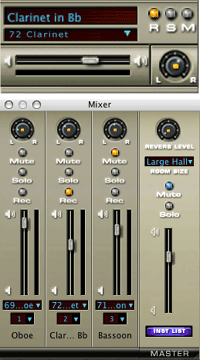
Remember notation? Stuff you hand to actual musicians? (Remember them?) Score production remains a very big deal, especially since some of us find hand-scoring about as much fun as digging trenches with our teeth.
MakeMusic this week has announced preorders and feature set for their next release of Finale, Finale 2006, continuing their annual upgrade ritual. A bit like Star Trek movies, lately even-numbered years have been bigger than odd-numbered years. Finale 2004, for instance — major upgrade. Finale 2005 — indispensable for some, but a relatively minor upgrade. (Though I do hear Spock comes back to life.)
One thing I have noticed in the larger upgrades in recent years is lots of eerie similarities to Finale’s main rival, Sibelius. So, I’ll divide up this year’s upgrade into genuinely cool features and “me-too” features. (Not necessarily a criticism, mind you: what’s great about rivalries is they tend to spur new development.) Read more for the breakdown.
Cool:
Native Instruments VST/AU integration: This is just too cool for words. But why will neither notation product integrate real VST/AU support? Or, while you’re at it, ReWire?
Integration with Garritan Orchestral Library: Sibelius has had a Kontakt Player-powered sound library for years, but Garritan sounds better and has more features.
Tap tempo: For those of you used to recording this way, this is great.
Sequener-like controls: Finale has been gradually adding sequencer features to its notation product, and the new Studio View gives you mixer-style controls in the notation view.
Mid-measure repeats, measure splits: If you’re not an engraver, you don’t know or care about this. But these are the kinds of tricky jobs at which Finale really is better than Sibelius.
Me-too:
Textured paper: Okay, this is just silly. Only MakeMusic could so proudly trumpet a feature as useless as textured on-screen paper so shamelessly, when Sibelius version 1 had this feature.
Engraver copy: Checkboxes for individual elements of a selection, straight out of Sibelius. Matter of taste: I still prefer Sibelius’ selection tools, though Finale die-hards love things like the Mass Mover.
Mixer view: Clearly a copy of Sibelius’ mixer, though Finale’s implementation does look more mature.
Backwards compatibility: NOT including backwards compatibility in previous releases = big mistake. But at least they finally corrected this, and XML import/export is a real boon.
Chord analysis: Long in plugin form in Sibelius, though probably better-implemented here. But this is on the list to encourage you to go back to school for theory if you can’t analyze a G7 chord. 😉
Mac anti-aliasing: This is because I complained about the ugly screen output in my Macworld review, isn’t it?
Overall, I’d say this is more of a Voyage Home (Star Trek IV) than a Wrath of Khan (Star Trek II). If you’re a Finale user, you’ll probably want it. The real story is the fantastic sequencer/MIDI controls, tap tempo, and virtual instrument integration. As for bread-and-butter notation, that’s limited comparatively (though handbell lovers will appreciate the new — oh, never mind).
So where’s Sibelius 4? That’s the big question. Sibelius’ upgrade cycle is generally considerably longer than Finale’s, but I expect this to be a big upgrade — and I think it’s likely to show up soon. Stay tuned. And in the meantime, I look forward to getting my hands on the new Finale, even though I think I’ll stick to Sibelius for producing my own scores.